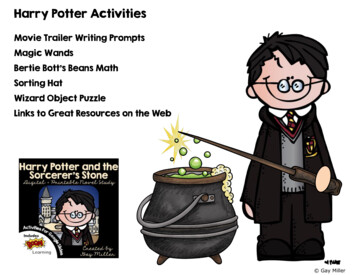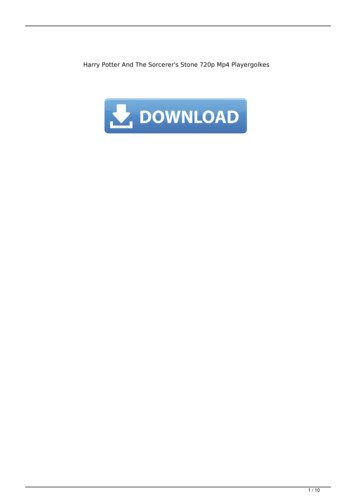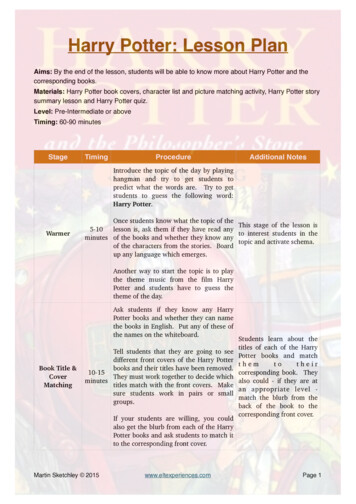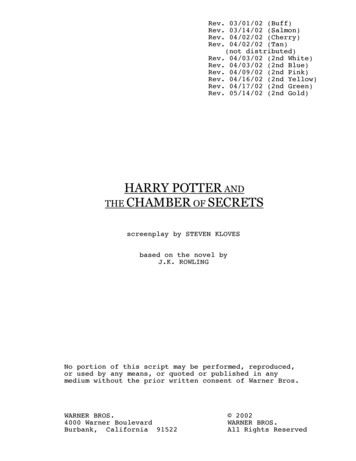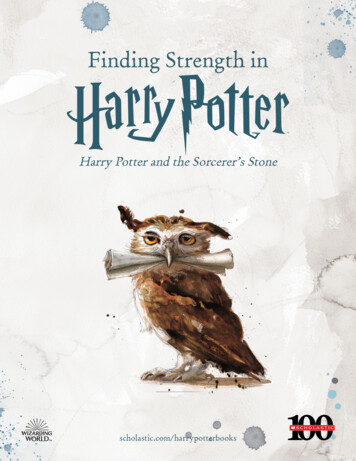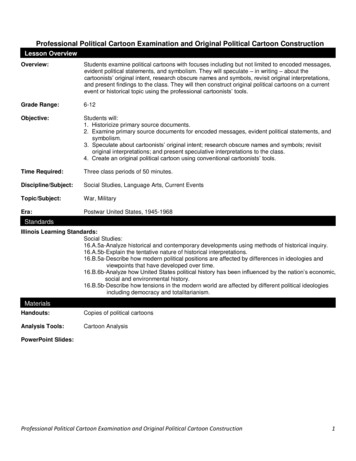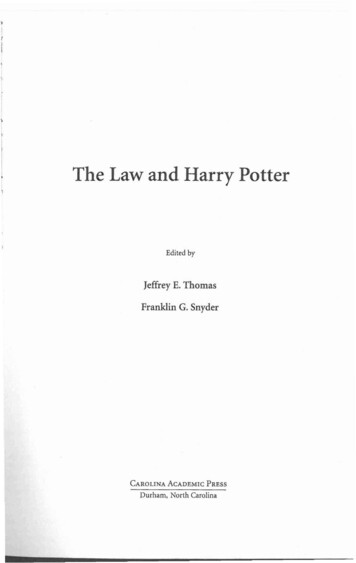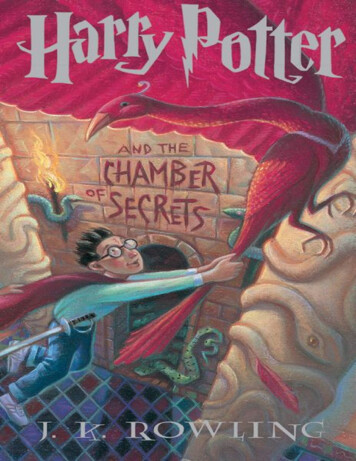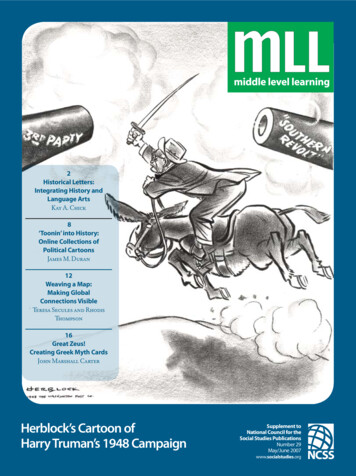
Transcription
2Historical Letters:Integrating History andLanguage ArtsKay A. Chick8‘Toonin’ into History:Online Collections ofPolitical CartoonsJames M. Duran12Weaving a Map:Making GlobalConnections VisibleTeresa Secules and RhodisThompson16Great Zeus!Creating Greek Myth CardsJohn Marshall CarterHerblock’s Cartoon ofHarry Truman’s 1948 CampaignSupplement toNational Council for theSocial Studies PublicationsNumber 29May/June 2007www.socialstudies.org
Middle Level Learning 29, pp. M –M7 2007 National Council for the Social StudiesHistorical Letters:Integrating History and Language ArtsKay A. ChickIntroductionIn 1948 a woman named Lucile in Newark, Delaware wrote to her family in Blairsville,Pennsylvania, about the presidential election of 1948. The letter is an interestingexample of one person’s opinion about a historic event (Figure 1). In this article,I discuss some of the benefits and challenges of using personal, historical letters astools for teaching and suggest how such a lesson can serve the purpose of curriculumintegration. I help students analyze and comprehend a significant event in history withthe use of this lesson.1 At the end of the article, I list extension activities that emphasizethe six language arts, so that teachers might provide students with experiences toimprove their literacy skills while also fostering historical knowledge and inquiry.“I Was There”Primary sources are materials such as diaries, oral histories, letters, photographs,drawings, and maps that were created bypeople who experienced or witnessed ahistorical event. They represent momentsin history that can provide insight intohistorical events, time periods, people,and places.2As teaching tools, primary sourcesoffer significant enhancements to theusual secondary sources, such as textbooks or instructional films. First, aprimary source can stimulate curiosity,promote historical inquiry, and fostercritical thinking. Original historicalsources encourage students to observe,make inferences, and ask questions, justas historians do. Second, they humanizehistory, which provides human interestand allows students to analyze the experiences, behavior, thoughts, and feelings ofpeople from the past. Once students haveacquired background information on historical events and time periods, a deeperunderstanding comes from examiningdocuments that foster comprehension of May/June 2007how people participated in and reactedto events as they happened.3Finally, original documents assist students as they become skilled in reading,writing, and research. Primary sourcesoften contain vocabulary and spellingthat is challenging, and content that isnot easily comprehended. Locating documents, even with document facsimileseasily available on the Internet, requirespatience and diligence. These types ofreading, writing, and research skills areoften new to students, but are necessaryfor them to make meaning from the document in front of them.Rough Drafts of HistoryThe nature of primary sources is verydifferent from secondary sources suchas most textbooks or children’s literature,where authors usually provide their ownanalysis of history. Primary sources challenge students to begin creating their ownviews of the past.Using primary sources can foster critical thinking. Because primary sourcescarry the perspective of the writers, twodescriptions of the same event, writtenby two different people, may contradictone another. For example, letters, newspaper editorials, and oral histories of theTruman v. Dewey election could containvery different points of view from thatof the author of the letter in Figure 1.Therefore, no single source can be considered unquestionably true and accurate.It is the teacher’s responsibility to assiststudents as they consider various viewpoints and make inferences about themeaning of different passages. Thus, theanalysis of primary sources can be quitecomplex, but introducing middle schoolstudents to the challenge is valuable formany reasons.A Unique ContributionHistorical letters are a primary sourcethat is available in abundance in somecommunities. Especially (but not exclusively) among the well-educated, earliergenerations were prolific letter writers,with correspondence often passingbetween writers on a daily basis. Somewriters would begin a letter at the beginning of a week, adding new informationfor several days before mailing it. In theestate of one elderly woman, over 400letters were found.4 Composed from theearly 1900s through the 1950s, the letters tell of her brother’s participation inWorld War II, the Pennsylvania flood of1936, Hitler’s invasion of Austria, andher experiences in college. Letters of thistime period often detailed the daily lifeof individuals, highlighting events suchas clothes and hair washing, cleaning,
and meal preparation. They not onlyprovide insight into historical events,but allow students to compare and contrast earlier generations with their own.Students must be reminded, however,that letters provide only a snapshot ofan event in history, and do not grant usthe complete story. Students must fill inthe gaps, just as historians do.At the local level, many historicalsocieties acquire letters and file or storethem by topic or time period. Such acquisitions are often available to schoolsfor historical studies. Collections canbe found in books such as Dear Mrs.Roosevelt: Letters from Children of theGreat Depression5 and articles such asEli Landers: Letters of a ConfederateSoldier,6 which provides teachers withdiscussion questions, teaching ideas, andextension activities.Letters OnlineFor teachers who are not able to easily find letters in their community, theinternet is a valuable source for documentretrieval. I’ve provided a small sample ofonline citations to letters from select periods in our nation’s history, which teachersmay wish to integrate into social studiesclassrooms (Figure 2). For example, inthe History Matters collection at GeorgeMason University, teachers can select atopic such as women, military history, orcontemporary United States, and thenselect letters and diaries as the primarysource.7 Collections appear with linksand a description of each resource. Forexample, by selecting “ContemporaryUnited States,” teachers can access theNational Baseball Hall of Fame andMuseum. By typing “Jackie Robinsonletters” in the search box, readers canretrieve a letter written by Senator JohnF. Kennedy to Jackie Robinson in 1960,concerning the senator’s desire for “firstclass citizenship for all Americans.” 8Letters can also be located at theLearning Connections webpages of theAmerican Memories collections at theLibrary of Congress (Figure 2). Thiswebsite, designed specifically for teachers, contains alphabetized collections ofprimary source documents, includingletters. For example, by clicking on thecollection, “California As I Saw It: FirstPerson Narratives of California’s EarlyYears, 1849-1900,” teachers can accessthe letters of Franklin A. Buck, a Yankeetrader in the gold rush.9Dewey v. TrumanHistorical letters are one type of primarysource that is easily integrated with language arts instruction. Some educatorsstate that a primary document is bestpresented after students have backgroundknowledge of the time period, or of a specific historical event, or both.10 However,letters can also be used as an anticipatoryset to invite student attention, curiosity,and engagement, and set the stage for whatis to come as the lesson progresses.Consider again the letter written byLucile, describing her reactions to thepresidential election of 1948 (Figure 1).I distribute this letter to students and weread it aloud. (I ask four students to eachread aloud one paragraph.) I ask the classto consider key phrases and discuss theirmeaning. For example, students mightdiscuss why people in 1948 would belistening to election results over the radio,and how that experience might be different from watching the results on television, as we often do today.I ask students what this phrase means:“Maybe he has ability never seen, at leastlet us hope for it .” Do students understand that “he” refers to Harry S. Truman?Can they explain that, although Trumanis now considered to be one of our greatpresidents, his potential for leadershipwas not evi dent to many Americans in1948?Students can discuss what they alreadyknow about Truman and how he firstcame to be in office. Ensure that studentsunderstand that the circum stances of hisfirst term (he became president upon thedeath of Franklin D. Roosevelt) affectedhow the public perceived his legitimacyas president, until he won an election forthat high office.To further study this (or any) letter,students can use a Letter Analysis Form(Figure 3).11 After they have completedtheir forms individually, they can compare responses with a partner, and thendyads can discuss their analyses with theclass. Questions on the Letter AnalysisForm can be used to initiate discussion,which is an important component ofsocial studies and language arts lessons.Students need opportunities for freeflowing discussion and reflection, andletters such as this are crucial elements insuch conversations. As students begin toask their own questions and gain experience in historical inquiry, teachers mayact as facilitators.12 They guide the process by asking students to consider whatelse they might like to know about the1948 election and this period in history,or how they might demonstrate what theyhave learned.Extension ActivitiesAs students gain knowledge about thishistorical event, they can demonstratewhat they have learned through a quiz,but teachers should also consider usingextension activities, which are designedto provide choice and promote creativity. Extension activities can also providestudents with experience in all six of thelanguage arts, listening, speaking, reading,writing, viewing, and visually representing. Moreover, extension activities areperformance-based, so students demonstrate and apply their knowledge ratherthan reiterate information on an exam.ON THE COVER: “Cannon to Right of Them, Cannon to Left of Them.” (Published in theWashington Post on February 23, 1948. Library of Congress collection). During the 1948presidential election, Southern Democrats (led by Strom Thurmond) rebelled, protestingPresident Harry Truman’s civil rights program. Left-leaning Democrats split off to form theProgressive Party (led by Henry A. Wallace). This prompted cartoonist Herb Block to invokethe heroic, if ill-fated warrior in Alfred Tennyson’s poem “The Charge of the Light Brigade.”Truman surprised almost everyone, and proved pollsters’ predictions wrong, by winning theelection in November.Middle Level Learning
Figure 1. May/June 2007
Language arts activities can be completedindividually or in small groups. Extensionactivities for middle school students completing a study of the 1948 election arenot hard to imagine (Figure 4). Studentschoose from among eleven options, orcreate their own activity with teacherinput and approval.In addition to sharing with classmates,students might benefit from sharing extension activities and expertise with a largeraudience. Give students the opportunityto demonstrate the knowledge gainedfrom their work by giving a presentationto parents, the elderly, or children in ayounger grade. Such a culminating eventelevates the status of students’ researchand helps them internalize their knowledge and discoveries.ConclusionA lesson using historical letters can makea unique contribution to the integrationof history and the language arts. Thisprimary source, providing a snapshot ofhistory, challenges students to developtheir own insights about historicalevents and people. Whether used atthe beginning or the end of a unit ofstudy, the work of analyzing a historical letter invites curiosity, engagement,critical thinking, and research. Personal,historical letters can rarely serve as astand-alone, authoritative source; theyare rather a catalyst, energizing studentsto extend their historical thinking andpursue an active understanding of theirsocial world.Notes1. The letter, excerpted in this article, is in the privatecollection of the author.2. Carol Fuhler, Pamela Farris, and Pamela Nelson,“Building Literacy Skills Across the Curriculum:Forging Connections with the Past ThroughArtifacts,” The Reading Teacher 59, no. 7 (April2006); Susan Veccia, Uncovering Our History(Chicago, IL: American Library Association, 2004),3.3. Keith Barton, “Primary Sources in History: BreakingThrough the Myths,” Phi Delta Kappan 86, no. 10(June 2005); Monica Edinger, Seeking History:Teaching with Primary Sources in Grades 4-6(Portsmouth, NH: Heinemann, 2000); Veccia, 3.4. These letters are in the private collection of theauthor.5. Robert Cohen, ed., Dear Mrs. Roosevelt: Lettersfrom Children of the Great Depression (Univ ersityof North Carolina Press: Chapel Hill, 2002); MaryMason Royal, “Maybe You Could Help?” MiddleLevel Learning 22 (January/February, 2005): 2-8.6. Stephanie Wasta and Carolyn Lott, “Eli Landers:Letters of a Confed erate Soldier,” Social Education66, no. 2 (2002).7. American Social History Project/Center for Mediaand Learning (CUNY) and the Center for Historyand New Media (George Mason University),“History Matters: The U.S. Survey Course on theWeb” (2006), historymatters.gmu.edu/.8. National Baseball Hall of Fame. “Primary SourcesJackie Robinson” (Cooperstown, NY: NBHF, 1999),at www.baseball halloffame.org/education/.9. Library of Congress. “American Memory Collections”(Washington, DC: Library of Congress, 2006),memory.loc. gov/learn/.10. Theresa McCormick, “Letters from Trenton, 1776:Teaching with Primary Sources,” Social Studies andthe Young Learner 17, no. 2 (November/December2004): 5-12.11. The Letter Analysis Form was modified from aWritten Document Analysis Worksheet created bythe National Archives and Records Administration,www.archives. gov/education/lessons/worksheets/document.html. Let students know that it is okay to write“Unknown” where appropriate on this form.12. Laurel Singleton and Carolyn Pereira. “CivilConversations Using Primary Documents,” SocialEducation 69, no. 7 (November/December 2005).Kay A. Chick is an associate professor of curriculum and instruction at Penn State Altoona,Pennsylvania.Figure 2. Examples of Historical Letters Available OnlineLetter Writer and RecipientSarah Bagley toAngelique MartinAbsolom A. Harrison toHis WifeHistorical PeriodWomen’s Rights, 1846–1848Civil War, August 2, htmwww.civilwarhome.com/letter15.htmlOnline PublisherHistory Matters, GeorgeMason UniversityCivil War Home, locatedthrough Louisiana anklin A. Buck narrativeCalifornia’s Early Years,1849–1900Capt. Robert Hanes to HisWifeWorld War I, 1914–1916A fifteen-year-old girl toMrs. Eleanor RooseveltThe Great 0136.htmLearning Connections,American Memory, Library ofCongressDocumenting the South,University of North CarolinaThe New Deal NetworkMiddle Level Learning
Figure 3. Letter Analysis FormDate of letter:Location from which letter was mailed:Author of the letter:Position (Title) or information known about this author:Recipient of the letter:Position (Title) or information known about this individual:Location where this letter was received:Unique physical characteristics of the letter (check one or more):Interesting letterheadHandwrittenTypedSeals“Received” stampOtherAnalysis of the ContentA. Why do you think this letter was written?B. List three things the author said that you think are important or interesting and explain why.C. List two things the letter tells you about life in the United States at the time it was written.D. What perspectives, viewpoints, or bias does the author communicate?E. Write a question to the author that is left unanswered by the letter.Source: This worksheet is based on materials from “Teaching with Documents: Lesson Plans” at www.archives.gov/education/lessons/. May/June 2007
Figure 4. Extension Activities for the Presidential Election of 1948Research the campaigns of Harry S. Truman, Thomas Dewey, Strom Thurmond,and Henry A. Wallace for the presidential elections of 1948. Then choose one ofactivities below as your culminating project for this unit of study. Your work willbe graded, and it is due .1.Create interview questions and interview an elderly person who remembers theelection of 1948. Videotape your interview and share it with the class.OnlineResources forStudentsAmerican President (Univ. of Virginia),“Harry S. Truman: Campaign andElections,”www.millercenter. Perform a newscast from the past by interviewing Truman or Dewey the day beforethe election, the day after, or both.Design posters for the campaigns of Truman and Dewey that state the position ofeach candidate on what you believe to be the significant issues in that election.Draw a political cartoon based on newspaper accounts of the 1948 presidentialelection.5.Write and perform a speech supporting one of the two major candidates.6.Write a news editorial for publication on the day after the election of 1948.7.Research ways that technology has changed campaigning and elections since 1948.Display your results as a poster or PowerPoint presentation.8.Compose and perform a musical composition that reflects the events of the 1948election and citizens’ reactions to it in the musical style of that era.9.Write a creative essay describing how American history might have been different ifeither Dewey, Wallace, or Thurmond had been elected.The Internet Public Library, “Harry uman Presidential Museum andLibrary, “Truman Biographical oks forStudentscourtesy www.lernerbooks.com2.10. Write and illustrate an acrostic poem, a biopoem, or a concrete poem that represents your understanding of the 1948 election or one of the candidates.11. Perform a skit representing reactions to the newspaper headlines following the1948 election.12. (Student’s idea for a project) I would like to:Cannarella, Deborah. Harry S. Truman(Profiles of the Presidents). Minneapolis,MN: Compass Point Books, 2002.Lazo, Caroline E. Harry S. Truman(Presidential Leaders). Minneapolis,MN: Lerner, 2002.Morris, Jeffrey B. The TrumanWay (Great Presidential Decisions).Minneapolis, MN: Lerner, 1994.I will work individually, or I would like to work with:Otfinoski, Steven. Harry S. Truman:America’s 33rd President (Encyclopediaof Presidents). Danbury, CT: Children’sPress, 2005.Middle Level Learning
Middle Level Learning 29, pp. M –M11 2007 National Council for the Social Studies‘Toonin’ into History:Online Collections of Political CartoonsJames M. DuranWith the advent of the Internet, a free and extensive collection of editorialcartoons covering various periods throughout American history has been placed atthe fingertips of every social studies teacher who has access to the web. As is oftenthe case, however, teachers have too little time to locate and review these educationalresources. I have reviewed five sites that contain a variety of editorial cartoons andprovide practical ideas about how to incorporate these images into lesson plans forthe classroom.1relaying the multitude of perspectivesthat existed at the time on the issues ofslavery and the Kansas Territory, JohnBrown’s raid on the armory at Harper’sFerry, and events leading up to the splitof the Democratic Party into Northernand Southern factions.When Benjamin Franklin created his1754 “Join or Die” cartoon in an attemptto persuade colonists to unite in the coming war against France, he could hardlyhave imagined the impact cartoonswould go on to have in today’s media.The sites described here are large collections of drawings, but they also provideresources about how such images canbe interpreted as powerful, but partialand imperfect, samples of the historicalrecord. Such critical analysis is a skillevery teacher must include as part of anylesson that introduces cartoons into theclassroom (Handout, page 11).such an exploration, the publishers ofHarper’s have compiled digital versions ofeditorial cartoons covering the fourteenpresidential elections from 1860 to 1912.The site draws upon Harper’s Weekly, awell-known publication of that period,as well as a variety of other electroniccollections, averaging fifty cartoons,campaign banners, and political printsfrom each election.Herblock’s History: PoliticalCartoons from the Crash to ntro-jhb.htmlParticularly useful at theHarper’s site isthe fact that each cartoon is paired withan explanation of the image (as well asthe sometimes-cryptic symbolism withinit) that places it in its proper historicalcontext. Take for example the election ofAbraham Lincoln in 1860. The imagesfound on this site do a superb job ofhis work from his early days as a 19-yearold staff cartoonist at the Chicago DailyNews (his first cartoon was a 1929 pieceadvocating the preservation of ournational forests) to his final days at theWashington Post. The site includesHerblock’s illustrated essay about hisprofession and its usefulness in a freeHerbert Lawrence Block (1909–2001),better known as “Herblock,” is viewedby many to be the pre eminent editorialcartoonist of the twentieth century. ThisLibrary of Congress website chroniclesHarper’s Weekly: The PresidentialElections 1860–1912elections.harpweek.com/There exist few more appropriate windows into the soul of America’s past thanits presidential elections. From the issuesaddressed by the candidates to the campaign methods utilized by the politicalparties of the day, an exploration of theseelections allows students of history toplace their fingers firmly on the pulseof the nation at that time. To facilitate May/June 2007
society, which would be quite readablefor most middle school students. “Thepolitical cartoon is not a news story andnot an oil portrait. It’s essentially a meansfor poking fun, for puncturing pomposity,” says Herblock. “If the prime role ofa free press is to serve as critic of government, cartooning is often the cutting edgeof that criticism.”Over his seventy plus yeas as a cartoonist, Herblock witnessed first hand andcommented on the twentieth century’smost memorable people and events. Hisdrawings capture the era of the GreatDepression, the Nazi menace, WorldWar II, the Civil Rights Movement, andthe Viet Nam War. He seemed to fear noreprisals in the 1950s during WisconsinSenator Joseph McCarthy’s hunt forcommunists (Herblock coined the term“McCarthyism”) or during the Watergatescandal of the early 1970s that endedRichard Nixon’s presidency. In recognition of his work during that period,Herblock was mentioned alongside BobWoodward and Carl Bernstein when theWashington Post was awarded the 1973Pulitzer Prize for Public Service.Herblock also received the PulitzerPrize on three separate occasions (1942,1956, and 1979). For his lifetime contributions, he was awarded the PresidentialMedal of Freedom, the nation’s highestcivilian award, in 1994. In conferringthe award, then President Bill Clintonacknowledged Herblock’s “service to ourdemocracy and to humanity. [advancing] the common interest of freedom-loving people, not only here at home butthroughout the world.”Library of Congress Prints andPhotographs Reading Room,Caroline and Erwin Swann Foundation for Caricature and Cartoon.www.loc.gov/rr/print/swann/As impressive as the works of HerbertBlock undoubtedly are, they representonly a small piece of the enormous piethat is the cartoon collection of the U.S.Library of Congress. This site containsnumerous on-line exhibits, each onecontaining images capable of servingas an invaluable teaching resource ontheir own (one exhibit alone, “’CartoonAmerica:’ The James Arthur Wood, Jr.Collection,” contains over 36,000 original drawings).One of the exhibits worthy of emphasis here is “Bill Mauldin: Beyond Willieand Joe,” which chronicles the militaryand civilian career of the two-timePulitzer Prize winner (www.loc.gov/rr/print/swann/mauldin/). Although best knownfor the cartoons and wartime observations created while a member of the U.S.Army’s 45th Infantry Division, Mauldinwas equally adept in capturing Americansociety in the post war era. His work during the Civil Rights Movement whileworking at the St. Louis Post-Dispatch,including thememorable imageof AbrahamLincoln sobbing atthe news of JohnKennedy’s assassination, remainsome of his mostenduring images.The webpage“American CartoonPrints,” while notmuch to look at, isa main crossroadsfrom which onecan access manycollections (lcweb2.loc.gov//pp/apphtml/appabt.html). Althoughthe search function can be somewhat cumbersome (using precise and descriptivekey words helps), once you have mastered it, you can be assured of finding animage from virtually any time period inAmerican History. Some of the drawingsare not the best quality (it seems that 18thcentury artists believed “more is better”and, thus, created works that are oftenvery cluttered), but the explanations andbackground information provided withimages make it possible to understand anduse them effectively in your classroom.The Library of Congress also providestools to assist teachers in using theseimages to create an effective educational environment. The section “It’s NoLaughing Matter” has background information and practice activities to assistthe reader in taking apart a cartoon anddeciphering its message (memory.loc.gov/learn/features/political cartoon/index.html).“What makes funny cartoons seriouslypersuasive? Cartoonists’ persuasive techniques do. All cartoonists have access toa collection of tools that help them gettheir point across.” The activities on thissite, along with the additional links foundunder “Resources for Teachers” provideteachers and students alike with tools toeffectively analyze political cartoons.Association of American cfmIf the ultimate goal of a social studiesteacher is the creation of an informedcitizenry, as it should be, then currentevents must be included into the curriculum. As John W. Gardner so eloquentlyput it, “History never looks like historywhen you are living through it.” Thus,the usefulness of editorial cartoons onceagain surfaces as a tool of instruction inthe history classroom.Middle Level Learning
Websites of Interestto TeachersApple Learning Interchange, “PoliticalCartoons in the Classroom.” A lessonfor students to gain experience withanalyzing political cartoons.ali.apple.com/ali sites/deli/exhibits/1000810/The Lesson.htmlLibrary of Congress, “It’s No Laugh ingMatter: Analyzing Political Car toons.”This site offers resources for teachers,lesson ideas, and a learning activity(that requires Flash plug /index.htmlNewsweek, “Analyzing PoliticalCartoons.” This Newsweek EducationProgram activity walks studentsthrough the process of analyzingpolitical oons.phpPBS, “Cartoon Commen tary.” Thislesson from the PBS Art in the 21stCentury Lesson Library focuses onthe history and analysis of raction/lesson2.htmlTruman Library and Museum,“Cartoons and Lesson Plans,” A collection of teaching materials andcartoons of the toon central.htmThe Association of American EditorialCartoonists (AAEC) website is a placewhere anyone can gather countless imagesthat inform and comment on the majorstories of the day. Combining works fromthe artists of more than fifty magazinesand newspapers across the United States,this website, which is updated daily, provides a single location for students andteachers view a variety of perspectives.Of particular use to teachers are“Cartoons for the Classroom” lessonplans, which are based on specific editorial cartoons (nieonline.com/aaec/cftc.cfm).2A biweekly two-page lesson plan is postedto the site for teachers to download andprint out for their individual classrooms.The first page is the lesson based on aparticular hot topic from current events.The second page is a blank cartoon onthe same event, where students can tryout their own captions/dialogue in aneffort to demonstrate their knowledgeof the event while placing an emphasison critical thinking. Teachers can accessan archive of lessons that dates back toSeptember 2003. As most issues are notentirely resolved within a day, this archiveallows teachers to follow an event as itover the weeks, as reflected in a series ofeditorial cartoons.AdditionalCollectionsFDR Cartoon Collection Database,www.nisk.k12.ny.us/fdr/index.htmlThe Impeachment of Andrew Johnson,www.impeach-andrewjohnson.com/Political Cartoons of the Lilly Library(1765-1865),www.indiana.edu/ liblilly/cartoon/cartoons.htmlOliphant’s Anthem,www.loc.gov/exhibits/oliphant/Political Cartoon Primary Sources,nhs.needham.k12.ma.us/nhs media/cartoonspolitical.htmlWorld War I 10 May/June 2007Daryl Cagle’s ProfessionalCartoonists Indexcagle.msnbc.com/Much like the AAEC site, Daryl Cagle’sProfessional Cartoonists Index providesa plethora of editorial cartoons, coveringa wide variety of perspectives on countless topics. (Cagle is the daily editorialcartoonist for MSNBC.com and a formerpresident of the National CartoonistsSociety.) In addition to current images,an archive of past cartoons, organizedby topic, provides detailed informationand points of view from events as farback as 2001. What sets Cagle’s site apartis its decidedly international flavor. Inaddition to a large number of cartoonsupdated regularly from American source
John Marshall Carter. Middle Level Learning 29, pp. M2-M7 2007 National Council for the Social Studies . trader in the gold rush.9 Dewey v. Truman Historical letters are one type of primary source that is easily integrated with lan-guage arts instruction. Some educators

